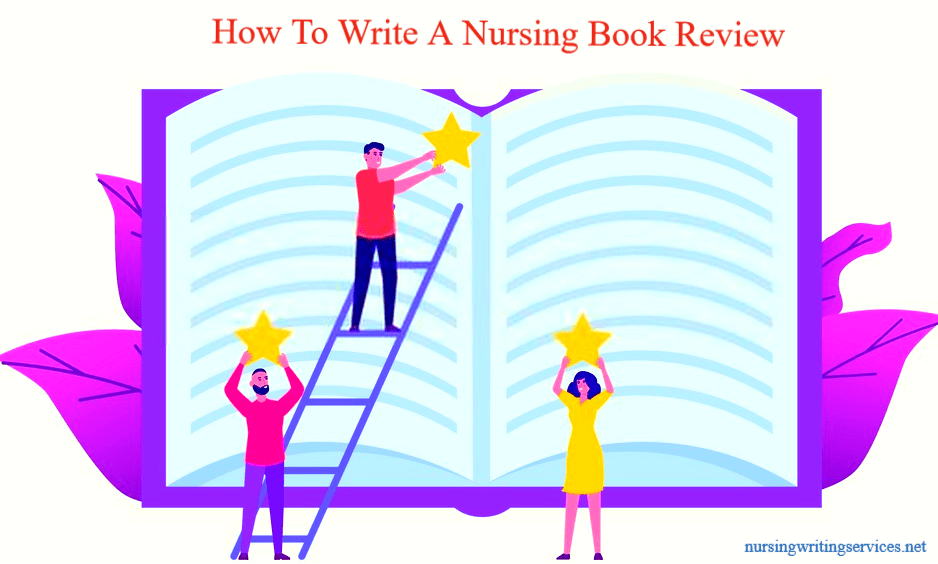Nursing Book Review: Definition, Structure, Step-by-Step Guide, & Tips
Page Contents
A nursing book review enables nursing students to demonstrate the author’s motivations for creating the piece and also offer a critique of the book – in its entirety. In other words, create an opinion about the author’s thoughts that are provided. Examine this guide from nursingwritingservices.net to discover how to create a professional nursing book review.

How To Write a Nursing Book Review?
What Is a Book Review in Nursing?
You may benefit greatly from understanding “what is a nursing book review.” Nursing book reviews are frequently assigned to nursing students to demonstrate their literature comprehension. It also helps to determine whether pupils have read the text. The essay format is critical to consider; see the nursing book review format below.
Nursing book reviews are offered to allow students to express their thoughts on the author’s concepts included within the book or excerpt. They are a type of literary criticism in which the author’s concepts, writing style, and quality are analyzed. A nursing book analysis is purely subjective in its assessment of the book. They are beneficial for individuals aspiring to be editors, as editing requires a great deal of criticism.
NursingWritingServices.net maintains a steady inventory of Nursing Study Guides and Reviews. As a result, we rely on these foundations throughout the research to support the complete writing of book reviews in nursing essays. Engage our nursing book review experts for any help.
Template for Nursing Book Reviews
An introduction, a body, and a conclusion comprise the format of a nursing book review.
- Introduction
- Analyze the cover and title of the book.
- You should include subtitles at this point.
- Please provide the author’s name.
- Thesis
- Provide a brief synopsis of the novel.
- Introduce the major elements of the body of your book review concisely.
- At this point, refrain from expressing any opinions.
- Body
- Utilize approximately three quotations from the author’s novel.
- In your own words, summarize the quotations.
- Indicate your personal interpretation of the quotation.
- Keep in mind that each point should be included within its paragraph.
- Conclusion
- Summarize the quotations.
- Summarize the explanations coherently.
- Complete the paragraph with a final sentence.
- This may contain your overall assessment of the book.
- Star-Rating (Optional).
The Step-by-Step Guide to Writing a Nursing Book Review
Writing a nursing book review is a task that may be accomplished for any publication. Nursing Book reviews can be used in any publication, regardless of category. Specific categories may be more difficult than others. On the other hand, the format for book reviews stays consistent. Consider these detailed tips from our expert nursing writers to discover how to create an in-depth nursing book review.
Step 1: Planning
Create an essay outline that summarizes all major topics in your book critique. Include details on the characters, the plot, and other significant aspects of your chosen literature. Each point you desire to discuss should have its body paragraph.
Consider the following points before writing a nursing book review:
- What is the book’s plot? You can write an effective review if you understand the plot.
- Is the plot enthralling to read? Is the plot compelling enough to keep you reading the novel? Did the plot entertain you? Is it effective at capturing the reader’s attention?
- Are the author’s writing techniques effective? Is the author implying anything between the lines? Who or what are they?
- Are the characters convincing? Are the characters logically constructed? As you read, the book provides a sense of reality for the characters?
- Would you suggest the book to a friend? Most importantly, would you recommend this book to others? Is it sufficient? Is it harmful?
- What could be ideal? Consider the quotes that could have been presented more effectively. Critique the author.
Step 2: Introduction
You have, most likely, picked your book. To begin, state the title of the book and the author’s name. Discuss the book’s cover. Prepare a thesis statement for your fictional story or non-fiction novel. Which concisely summarizes the book review’s quoted material.
Step 3: Body
Pick a single chapter or scenario to summarize. Include approximately three quotes in the body. Create your summaries for each quotation. You are also welcome to provide your perspective and interpretation of the quote. It is critical to include one quote in every paragraph.
Step 4: Conclusion
Highlight the summarized quotations and explanations in the body paragraphs. Following that, conclude your book analysis with a conclusion statement that conveys the book’s overall message. Consider the question, “Is it worth reading?” and provide a brief response. Nevertheless, writing between the lines. Avoid using the phrase “I enjoy/dislike this book.”
Step 5: Give the Book a Rating (Optional)
After completing a nursing book review, you may like to include a rating. Include a star rating to give your readers additional insight into the book’s quality. Book reviews with star ratings can be more successful than those without. However, this is entirely optional.
Nursing Book Review Writing Tips
- A lengthy introduction will almost always result in a worse grade: keep the introduction brief. Readers despise long introductions for any essay format.
- Writing fiction book reviews is recommended but not a must. However, evaluating fiction can be significantly more effective than writing about non-fiction.
- Avoid Comparing: refrain from comparing your chosen novel to other works you’ve read. This can be misleading for the reader.
- Opinion Matters: When writing book reviews, it is frequently suggested to include your personal perspective.
- Consult Templates: a book review template can assist a student in grasping the required writing style.
- Do Not Be Afraid to Critique: Generally, academic papers below the Ph.D. level do not require your personal viewpoint. On the other hand, there is an exception for book reviews.
- Utilize Positivity: Include a healthy mix of positive and critical comments.
- Avoid making stuff up in your review of The Chosen Novel. Examine only the material offered in the selected book.
- Have you enjoyed the book? Declare how much you enjoyed reading the book. This enhances the personalization of your book analysis.
Conclusion
Writing a nursing book review is an idea worth considering. Professors frequently assign this type of nursing assignment to students to help them demonstrate their comprehension of a novel. Following the nursing book review structure, as well as following step-by-step instructions, is quite beneficial for beginners. Writing tips are also beneficial for unfamiliar individuals with this form of nursing essay.
Do You have Difficulties with Your Nursing Book Review? You can rely on the help of our nursing experienced writers and editors for help. We respond quickly to any “write a nursing essay for me” inquiries. Engage our experts for a quick custom nursing book review.
Before reading the book, it is essential to consider the following:
- Title – articulate on the suggestion
- Preface and introduction – this is an excellent source of valuable information that replicates the author’s intention and the book’s scope under review. Also, consider if any limitations have been recognized and if the writer ignored essential features as far as the subject is concerned.
- Table of Contents – This is a good pointer to the book’s sequential arrangement considering the key ideas and their development topically or chronologically.
Points to anticipate while reading the whole book:
- What is the all-purpose field or genre? What is the value of the book?
- From what point of view is the book based?
- Do you agree or contest the writer’s perspective?
- Take notes as you continue reading the book and pinpoint essential passages that can form part of quotations during the review.
- Are you in a position to comprehend the thesis that the author presents, the “common thread”?
- What is the applicable style that the writer applies – is it formal or informal? Is this method appropriate to address the interest of the audience?
- Does the author accurately discuss the concepts? Is the language applied fathomable and convincing? Does the author develop the ideas logically? Which areas have efficiently been covered, and which areas are scanty? Does the author have precision in the information used?
- Do the conclusion, and the summary convince the reader?
- Assuming that there are footnotes, do they reflect well the information given in the paper? Does the reference replicate the information provided in the body of the text?
- If you find it appropriate, make comments on the paper format that reflects such issues as the binding and the layout, among others. Does the author make use of figures, maps, and illustrations, and if yes, do you find them to be ingenious?
- In case an index is provided, is it correct? What type of references did the author apply, primary or secondary? Comment on important omissions.
- Are there any worthy accomplishments that can be attributed to the book? Is further research needed? Compare this book with other books that were written by the author and any other text discussing similar issues although written by different authors. Prioritize the books in the reference list.
- Writing Outlook
- It must have a topic, writer’s name, the city it is published and by whom, time of publication, corrections made, the number of pages, other characteristics, as well as cost and ISBN.
- Capture the reader by your introduction. Create a theme in line with the shortened account of the book. Follow the set rules because some who correct the book may approve a short theme, and some will not. Some individuals may like concrete and clear reasons why a publication is recommended for a subject; others may not be specific.
- Inspect the book you have gone through and not the one you speculate is authored by the same author.
- If the book stands amongst the rest, then endorse it, giving motives behind your endorsement, if your approval is plain without reasons to specify it.
- Add the writer’s information and what they are known for, his authorizations amongst other things that add value to the person of the writer.
- Consider the potential reader of the summarized outlook, whether the author is the owner of a library who would like to restock or a parent who would want to select a children’s book. The outlook must meet the demand of the potential reader.
- The outlook must end with a short highlight and a final review. No introduction of a new idea should be allowed here.
- A better view is possible when enough time is set aside for review.






